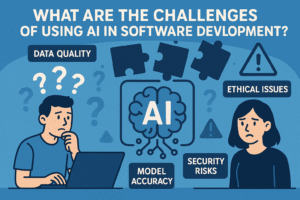Challenges of Using AI in Software Development

Artificial Intelligence (AI) is transforming software development, automating tasks, improving efficiency, and enhancing creativity. However, while AI offers exciting possibilities, it also presents a unique set of challenges that developers must navigate. Let’s explore some of the most pressing obstacles in integrating AI into software development.
1. High Learning Curve
AI tools and frameworks require specialized knowledge. Developers must understand machine learning concepts, neural networks, and data science principles to leverage AI effectively. This steep learning curve can slow down adoption and implementation.
2. Data Quality Issues
AI models rely on vast amounts of data for training. If the data is incomplete, biased, or inaccurate, the AI system can produce unreliable results. Ensuring high-quality, diverse datasets is crucial but often difficult.
3. Bias & Ethical Concerns
AI can unintentionally inherit biases from training data, leading to discriminatory or unfair outputs. Developers must be vigilant about ethical implications, ensuring AI decisions are transparent and equitable.
4. Complex Debugging & Lack of Explainability
Traditional software follows logical, deterministic rules, making debugging straightforward. AI-driven code, however, works on probabilistic models and neural networks, making errors difficult to trace and fix. AI’s “black box” nature means developers often struggle to interpret how decisions are made.
5. Security Risks
AI introduces new cybersecurity vulnerabilities. Malicious actors can manipulate AI models through adversarial attacks, poisoning datasets, or exploiting weaknesses in AI-driven applications. Securing AI systems requires constant monitoring and robust defensive strategies.
6. High Computational Costs
AI models, especially deep learning systems, require significant computational power. Training and deploying AI-driven applications can be expensive, demanding powerful hardware, cloud infrastructure, and energy resources.
7. Integration Challenges
Many existing software systems were not designed with AI integration in mind. Retrofitting AI into legacy codebases can be complex, requiring extensive reengineering and compatibility checks.
8. Regulatory & Compliance Issues
AI usage must comply with data privacy laws, security regulations, and ethical guidelines. Developers must consider GDPR, CCPA, and other frameworks when handling sensitive data through AI-driven applications.
9. Over-Reliance on Automation
AI can enhance productivity, but excessive reliance on automation may reduce human oversight and creativity. Developers should ensure that AI complements rather than replaces critical thinking and innovation.
Final Thoughts
While AI is revolutionizing software development, addressing these challenges is essential for responsible implementation. A balanced approach—combining human intelligence with AI-driven efficiency—can unlock the full potential of AI while mitigating risks.


